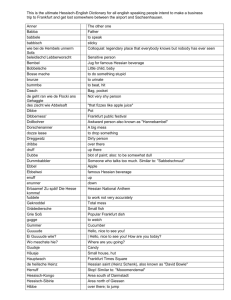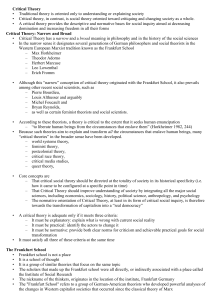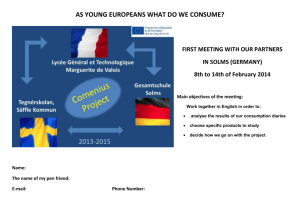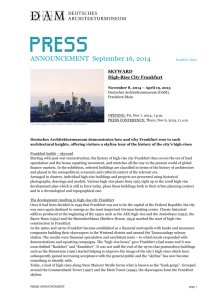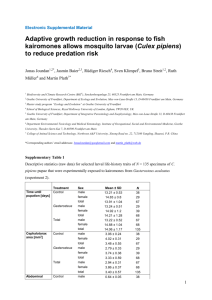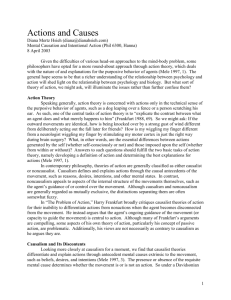The Book Trade in the Early Modern Period
advertisement
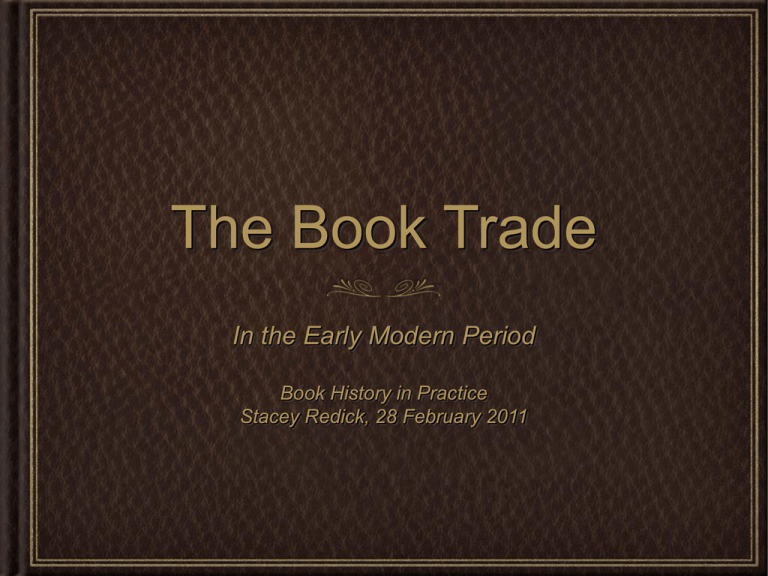
The Book Trade In the Early Modern Period Book History in Practice Stacey Redick, 28 February 2011 Table of Contents Histoire du Livre The Coming of the Book The Book Trade: Challenges The Book Trade: Commercial Network The Book Trade: International Fairs International Fairs: The Frankfurt Fair The Frankfurt Fair: Book Catalogs Questions Histoire du Livre “The new strain [of book history] developed during the 1960s in France... spread through publications like L’Apparition du livre (1958), by Lucien Febvre and HenriJean Martin..” - Robert Darnton, “What is the History of Books?” “Annales school” of socioeconomic history - a style of historiography developed by French historians in the 20th century. Studied the general pattern of book production, transmission and consumption over time. Materials studied: statistics from requests for privilèges, contents of private libraries, ordinary types of books. The Coming of the Book “The printed book played its part in a whole range of basic changes which were taking place at the time ... We hope to establish how and why the printed book was something more than a triumph of technical ingenuity, but was also one of the most potent agents at the disposal of western civilization in bringing together the scattered ideas of representative thinkers” (10). The story of the printed book is one which deals with the “effect on European culture of a new means of communicating ideas within a society that was essentially aristocratic, ... that accepted and was long to accept a culture and a tradition of learning which was restricted to certain social groups” (12). Sources: statistics, inventories, professional records The Coming of the Book statistics Basic data: sizes of editions Economic balance: printing enough, but not too much General pattern: 16th: editions of 1,000-1,500 copies (218) 17th: similar numbers, with slightly higher numbers (2,000) for religious texts and textbooks (219) What can this tell us about reading practices in the 16th and 17th centuries? The Coming of the Book history Focus: 15th to 18th Centuries (11) Europe - mainly France, Germany, Italy Development of printing increased the production of books and the audience for popular literature. Majority of texts produced were of interest to a much smaller population of readers (216). Problem: finding enough retail outlets Many of the international printing centers (Pettegree 76) Challenges in the Early Modern Book Trade Transportation Risks: Weather, robbery, war, accident, delay, misdirection (223). Piracy v. Regulation No medieval guild existed for printed books. Privileges granted not valid outside granting authority’s jurisdiction Censorship - religious and political How closely are these problems related to the ones that exist in book publishing, marketing and selling today? The Importance of Commercial Networks To sell enough merchandise as rapidly as possible, booksellers, printers and publishers needed strong commercial networks (216). Success depended on such networks. Example: Correspondence of Johann Amerbach Koberger Rusch The Importance of Commercial Networks People: Printers, publishers, booksellers but also scholars, editors, authors, collectors. Scholars corresponded to procure books, offer gossip, advice and news. Example: Willem Vorsterman, printer. International Fairs “The selling of books at fairs was an established custom from the earliest times, and persisted for centuries...” (226). The great fairs were held at Leipzig, Lyons, Frankfurt and Medina del Campo (226). Geography: Fairs generally occurred in cities built on commercial crossroads. International Fairs - advantages Advantages Regularity (226) Forum for networking Transportation of merchandise Market prediction Encouraged technical innovation Sales Accounts International Fairs - scheduling Printers and authors organized their schedules around the fairs. Example: Calvin “I will leave this topic to the next fair.” How would this type of statement affect readers and buyers of books? “The Fair” - Frankfurt “The most important book fair was originally at Lyons” (226). Yet: “Another book fair developed during the 16th century and became even more important than those of Lyons: The Frankfurt Fair” (228). Home of a major book fair from 1475, remained at the center of the international book trade for 200 years. Also played a significant role in the German book trade. Not an international center for printing or publishing. The Frankfurt Fair - schedule Two Frankfurt Fairs: One during Lent, one at Michaelmas. The Lenten Fair: dates, durations varied over time 1366-1383: two weeks 1384-1394: almost four weeks 1400: just under three weeks The Frankfurt Fair - schedule The Michaelmas Fair: Originally held around the feast of Assumption on 15 August Later: 24 August - 8 September 1349: 15 August - 8 September 1394: ended on 15 September late 16th century: began on a Monday between 6-12 September Highlight: Buchgasse, the main book trade thoroughfare (Flood 3). The Frankfurt Fair - people Booksellers, printers, publishers, paper merchants, typefounders, bookbinders, dye-casters, type engravers Scholars - to trade complimentary copies for other works. Authors - to promote manuscripts. Printers such as Johann Amerbach (from Basel) and Michael Wessler (in 1478), agents from bookseller Anton Koberger (from Nuremburg), and from printer Christophe Plantin (from Antwerp). The Frankfurt Fair - why so important? Accustomed to seasonal commerce Began as a major medieval fair in the eighth century. Was confirmed by charters in 1240 and 1330. Geographical location Was equidistant from major cities in Europe. Was situated at the center of major trade routes. Heart of Europe. The geographical disposition of Europe’s major printing centers (Pettegree 269). The Frankfurt Fair - catalogs “Among the most original features of the Frankfurt Fair were the catalogues which were produced of the books available at the fair ... catalogues of books for sale and in print were a very early feature of the trade and from at least 1470, if not earlier, agents employed by the big publishers drew up lists...” (230). In 1564 Augsburg bookseller Georg Willer produced the first general fair catalog. “In 1598 the Town Council decided to publish an official catalogue which came out without interruption until the 18th century and served as a source for the first bibliographic studies which were published in Germany in the 17th century” (231). Works Cited Darnton, Robert. “What is the History of the Book?” Daedalus 111.3. 1982. 65-83. Print. Febvre, Lucien and Henri-Jean Martin. “The Book Trade.” The Coming of the Book. 1958. Print. Febvre, Lucien. “Preface.” The Coming of the Book. 1958. Print. Flood, John L. “‘Omnium totius orbis emporiorum compendium’: the Frankfurt Fair in the Early Modern Period.” Fairs, Markets & the Itinerant Book Trade. Oak Knoll Press, DE. 2007. 1-42. Print. Pettegree, Andrew. The Book in the Renaissance. Yale University Press, New Haven. 2010. Print. Questions What can the study of numbers of edition sizes tell us about reading practices in the 16th and 17th centuries? How closely are these problems of the book trade (i.e. transportation, piracy, regulation and censorship) related to the ones that exist in book publishing, marketing and selling today? How would Calvin’s statement, “I will leave this topic to the next fair,” affect readers and buyers of books in the early modern period? How did book fairs like those of Frankfurt affect the (perception of the) fixedness of the book? What do you think of the approach of the histoire du livre scholars, and that of Febvre and Martin in particular? Others? The End.

